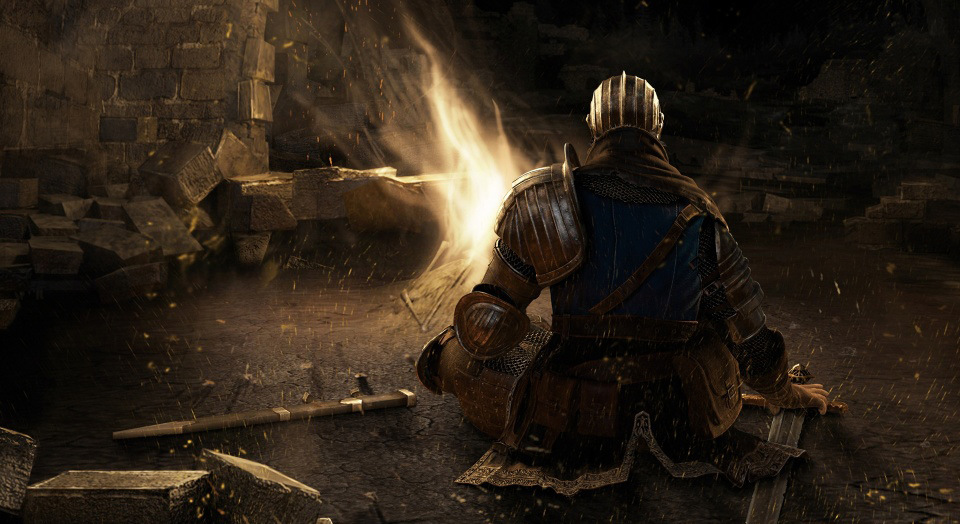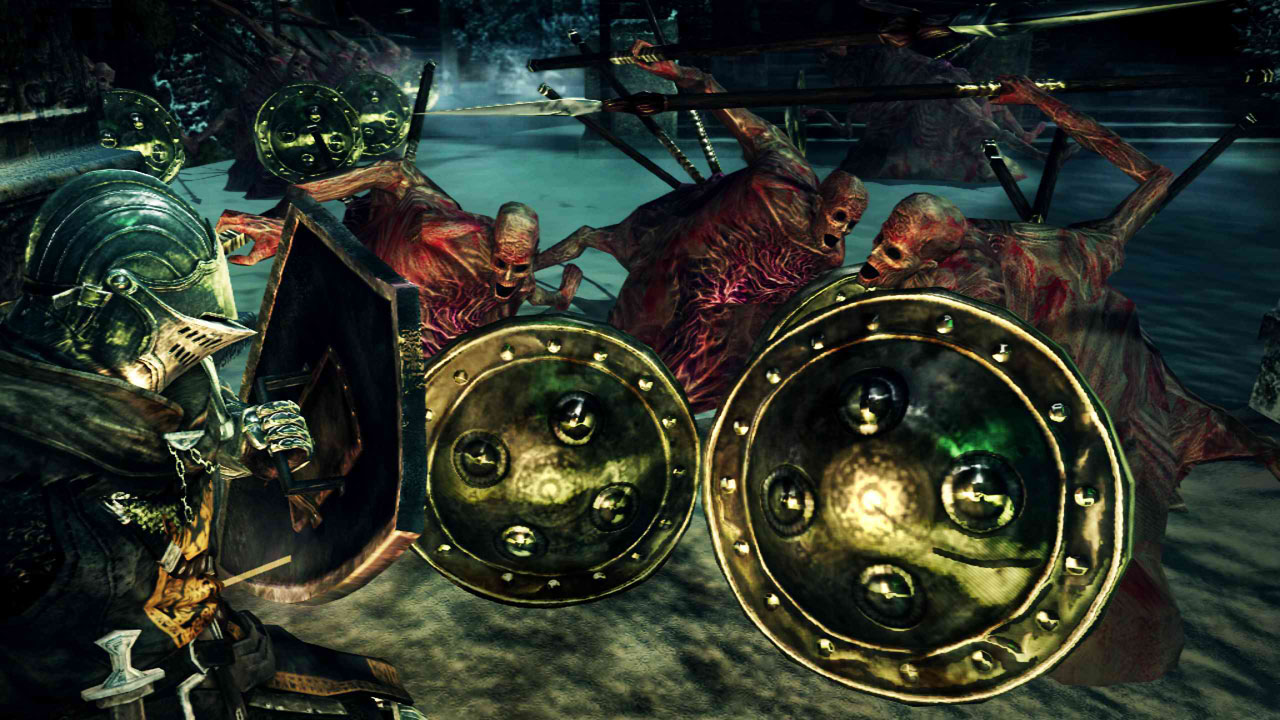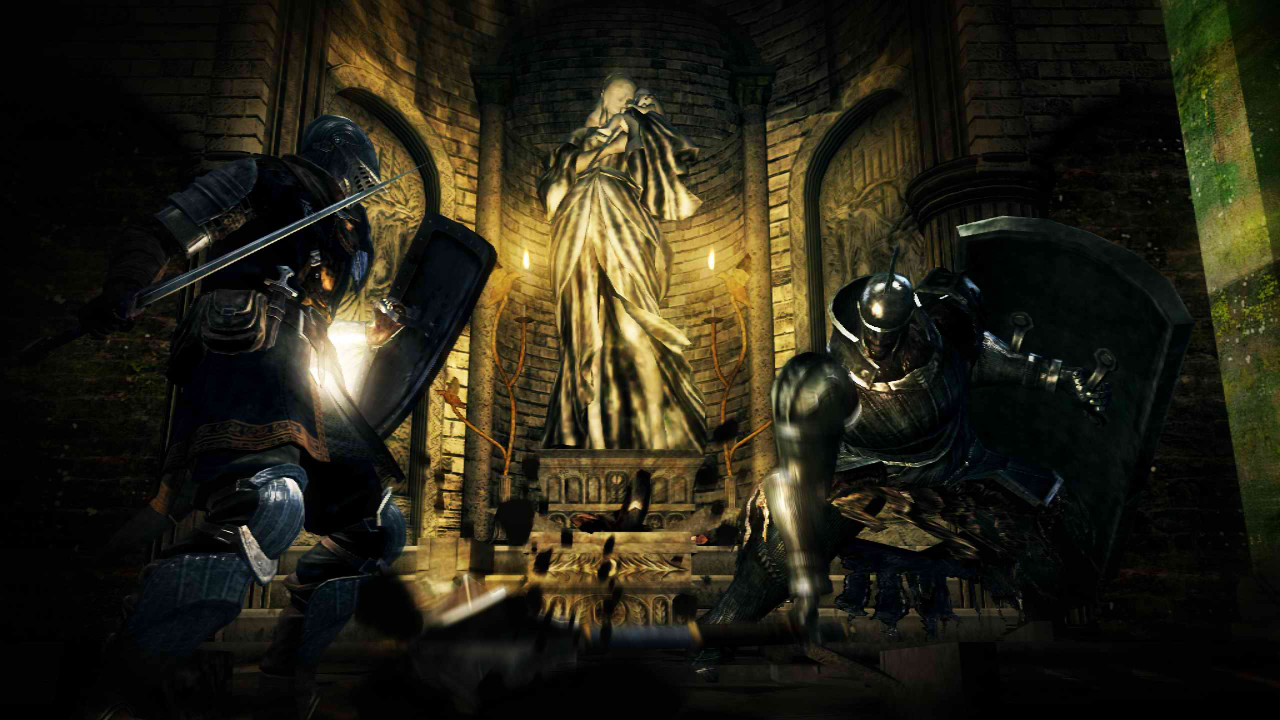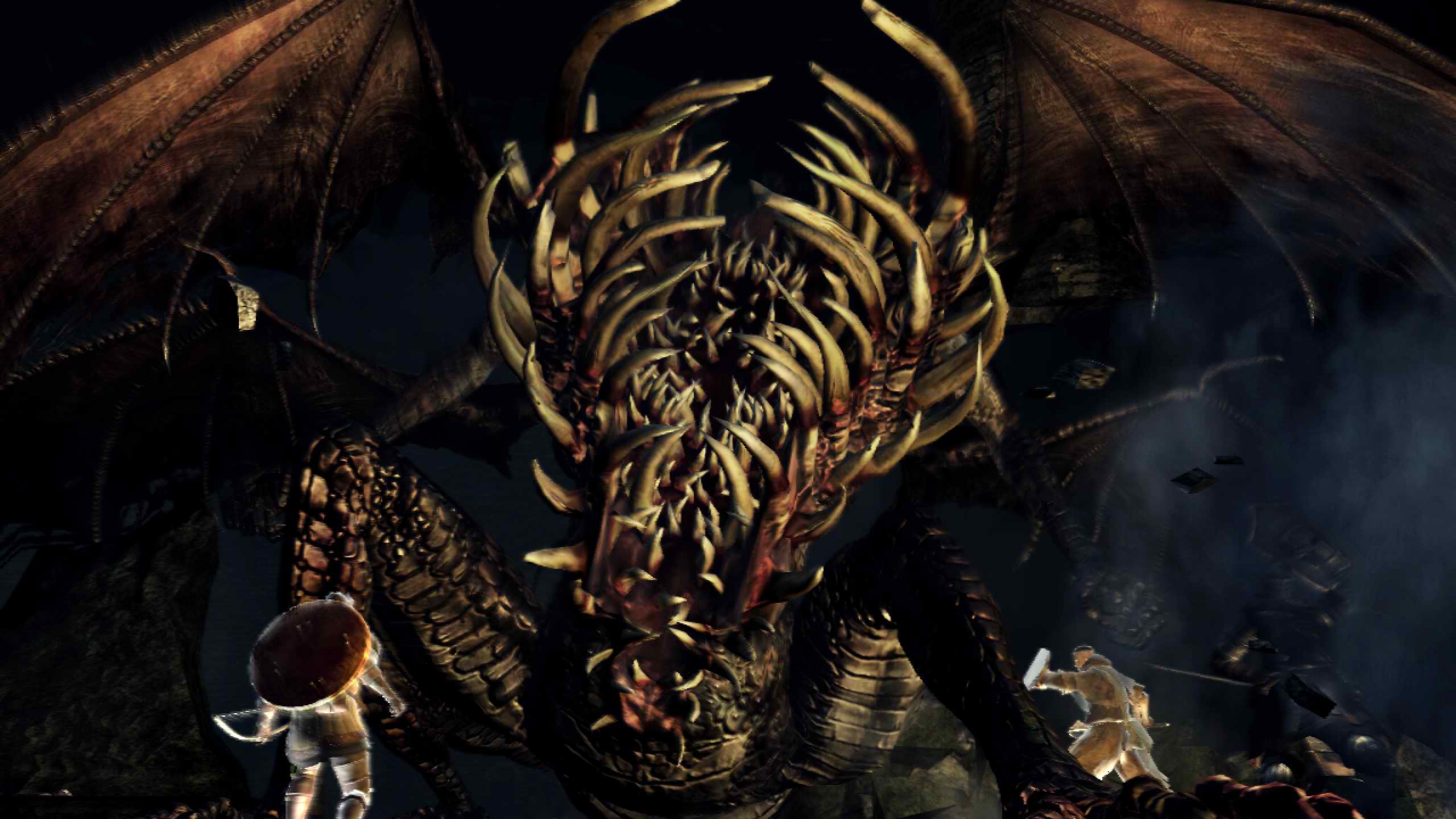 Japanese developer FromSoftware’s Dark Souls makes no grandiose statements of hope or heroism. You begin the game as a wanderer, clinging to life in a new dark age, with civilization all but collapsed and humanity broken. The land has been scarred by the flames of untold wars and disaster, and now a blanket of darkness lingers, threatening to consume even the last remnants of humankind. The player begins in a dank prison cell in the Undead Asylum, where the charred earth and cracked stone tiles around you act as a haunting reflection of your avatar’s own decaying face. The flesh of your head has been all but stripped bare, revealing a gaunt and deathly face. There is something strangely seductive in the sombre and macabre atmosphere of Dark Souls. Hopeless and alone, you venture forth.
Japanese developer FromSoftware’s Dark Souls makes no grandiose statements of hope or heroism. You begin the game as a wanderer, clinging to life in a new dark age, with civilization all but collapsed and humanity broken. The land has been scarred by the flames of untold wars and disaster, and now a blanket of darkness lingers, threatening to consume even the last remnants of humankind. The player begins in a dank prison cell in the Undead Asylum, where the charred earth and cracked stone tiles around you act as a haunting reflection of your avatar’s own decaying face. The flesh of your head has been all but stripped bare, revealing a gaunt and deathly face. There is something strangely seductive in the sombre and macabre atmosphere of Dark Souls. Hopeless and alone, you venture forth.
You are thrown into a harsh and unforgiving world, one which from the get go is populated with a variety of deadly foes – undead horrors that circle around you like starved wolves, giant demonic creatures that can crush your brittle body into the ancient stone floor with a single hammer-blow. Yet beyond the underlying mechanics, the fierce swordplay, the tactical combat and the crushing difficulty, the game is a fatally serene, almost spiritual experience. The sounds of lonesome footsteps whilst winding up ruined staircases, the thick oozing splashes as you wade your armoured warrior through putrid bogs and sewers, and the howling, occasionally whispering, winds as you explore cliff edges and towering monuments, all contribute to Dark Soul’s worldly experience. These sounds of the world do more than any soundtrack could, grounding, captivating, and building upon the game’s already almost unbearable suspense. It is in the minute moments of relative calm, between the furious scraps and the symphonies of clashing steel that you can most profoundly reflect on just how hauntingly authentic the world of Dark Souls appears to be.
 After managing to escape from the Asylum’s tutorial area, the game properly begins at Firelink Shrine – the hub area that links up the sprawling realm, and where NPCs that you meet during your arduous travels return in order to flog you useful goods and magical wares. The world stretches outward from the Shrine in several directions. The scale is breathtaking – a vast cliff face and cityscape lies ahead. Down below, jut more ruined landscapes, yet all of this pales in comparison to the mass of underground tunnels and depths that spread out beneath you like subterranean filaments. Nothing is signposted, and there is no map to speak of, yet all of the areas initially visible are traversable. Many of these zones are initially too dangerous for a novice to attempt, yet they remain open and accessible for the learned who have tread the treacherous walkways before, memorising the shortcuts and the ancient treasures that lie beyond regular rationale. An NPC lies leisurely by the warmth of the Shrine’s bonfire – he looks as if he has been resting there for an eternity. He mentions two ancient bells that need to be rung in order for you to pass on from these lands, yet he puts little faith in your ability to do so (even after you’ve rung one of them). It appears as though he has seen many an adventurer fail before you, give up in defeat, never to return.
After managing to escape from the Asylum’s tutorial area, the game properly begins at Firelink Shrine – the hub area that links up the sprawling realm, and where NPCs that you meet during your arduous travels return in order to flog you useful goods and magical wares. The world stretches outward from the Shrine in several directions. The scale is breathtaking – a vast cliff face and cityscape lies ahead. Down below, jut more ruined landscapes, yet all of this pales in comparison to the mass of underground tunnels and depths that spread out beneath you like subterranean filaments. Nothing is signposted, and there is no map to speak of, yet all of the areas initially visible are traversable. Many of these zones are initially too dangerous for a novice to attempt, yet they remain open and accessible for the learned who have tread the treacherous walkways before, memorising the shortcuts and the ancient treasures that lie beyond regular rationale. An NPC lies leisurely by the warmth of the Shrine’s bonfire – he looks as if he has been resting there for an eternity. He mentions two ancient bells that need to be rung in order for you to pass on from these lands, yet he puts little faith in your ability to do so (even after you’ve rung one of them). It appears as though he has seen many an adventurer fail before you, give up in defeat, never to return.
 As you press onwards, things can sometimes feel a little overwhelming. The ancient ramparts of the Undead Burg jut off into the distance as you make your way through the old castle town towards the first bell tower atop the Parish Church. “Hollowed” undead jump out at you from the darkest corners, whilst enemies wielding firebombs pelt you from the city rooftops. Even the first encounters pose a considerable threat, the enemies seek to surprise and trap all too confident heroes. Expect to die, and quite often initially, but with a bit of patience and determination, even the most malicious dungeon crawls can become rewarding experiences. The essence of Dark Soul’s difficulty centres around risk – not chance. Areas are highly intricate, balancing a sheer vastness of scope with an overwhelming sense of claustrophobia. The Depths is an almost infinitely deep cistern in which it takes several attempts to learn the branching routes, as does the infamous Blighttown with its towering vertical shanties. Each environment is finely crafted, cruel traps, tight engagements and luring treasure chests all placed with architectural precision.
As you press onwards, things can sometimes feel a little overwhelming. The ancient ramparts of the Undead Burg jut off into the distance as you make your way through the old castle town towards the first bell tower atop the Parish Church. “Hollowed” undead jump out at you from the darkest corners, whilst enemies wielding firebombs pelt you from the city rooftops. Even the first encounters pose a considerable threat, the enemies seek to surprise and trap all too confident heroes. Expect to die, and quite often initially, but with a bit of patience and determination, even the most malicious dungeon crawls can become rewarding experiences. The essence of Dark Soul’s difficulty centres around risk – not chance. Areas are highly intricate, balancing a sheer vastness of scope with an overwhelming sense of claustrophobia. The Depths is an almost infinitely deep cistern in which it takes several attempts to learn the branching routes, as does the infamous Blighttown with its towering vertical shanties. Each environment is finely crafted, cruel traps, tight engagements and luring treasure chests all placed with architectural precision.
These levels are an elaborate learning process where the challenge remains constant and you will never feel truly at ease. Yet once you have traversed the dungeons a few times, areas become easier to navigate and a network of shortcuts slowly materialise, weaving their way between areas new and old, back to the safety of Firelink Shrine. Yet the world continues to expand and unravel outwards, folding back further to entirely dwarf our intrepid adventurer. Bonfires, where you can rest and refill your Estus Flask (a healing potion), are you’re closest friend in the wilderness, yet they are scarcely placed and come with the price of resetting the surrounding area’s enemies. These important safe points become euphoric, their sparsity invoking dread and panic when first adventuring into unknown areas, as well as joy and relief when you finally spot their faint glowing embers from a distance. Treasure is scattered throughout the environment, hidden in alcoves and perched high up on perilous reaches. You are rewarded for exploring – and when the opportunity arises to risk everything in a leap of faith across a heightened archway or rooftop for the chance of a rare artefact, temptation wins out every time.
 Dark Souls is armed with a strong, mechanical combat system. Deadly back and forth exchanges between you and equally deadly opponents occur often, and as you strafe and toe in circles around them, your timed blocks and counter ripostes become advantages necessary to exploit. Position becomes vital in encounters too, as enemies can quickly dispose of you if you are flanked or backed into a corner. You can likewise flank them, if you are suitably nimble-footed, to deliver your own devastating backstab. You are also able to parry and execute counterattacks, although timing is vital and a miss-calculation always leads to a quick death. Rolling to avoid large, sweeping attacks, or beneath the legs of a larger beast to avoid a frontal assault, as well as going toe to toe and turtling under the iron safety of your shield are both valuable tactics, and are equally necessary throughout the game’s varied encounters. Bosses are a staple of the game’s formulae, and will no doubt be the largest cause of frustration. These prime evils are often menacingly designed and monumentally proportioned, making their demise at the hands of our comparably miniscule warrior all the more satisfying.
Dark Souls is armed with a strong, mechanical combat system. Deadly back and forth exchanges between you and equally deadly opponents occur often, and as you strafe and toe in circles around them, your timed blocks and counter ripostes become advantages necessary to exploit. Position becomes vital in encounters too, as enemies can quickly dispose of you if you are flanked or backed into a corner. You can likewise flank them, if you are suitably nimble-footed, to deliver your own devastating backstab. You are also able to parry and execute counterattacks, although timing is vital and a miss-calculation always leads to a quick death. Rolling to avoid large, sweeping attacks, or beneath the legs of a larger beast to avoid a frontal assault, as well as going toe to toe and turtling under the iron safety of your shield are both valuable tactics, and are equally necessary throughout the game’s varied encounters. Bosses are a staple of the game’s formulae, and will no doubt be the largest cause of frustration. These prime evils are often menacingly designed and monumentally proportioned, making their demise at the hands of our comparably miniscule warrior all the more satisfying.
 Loot and items play an important role in Dark Souls, as with any RPG. Although you may begin the game by choosing a specific class, such as a Knight or Pyromancer, the game is entirely flexible from this point forward. Your starting situation means little in the long run, and your character becomes highly customisable over the game’s duration. Stamina and Vitality become crucial in outlasting tougher enemies and bosses, allowing you to take additional punishment to both your shield and overall health pool. Strength and Dexterity may be required to handle different weapons, with certain equipment granting a bonus for points spent in one or the other statistic. Faith, Intelligence and Attunement affect your magical effectiveness. You can just as easily turn your armoured knight into a robe-wearing fire-wielding magician, as a bulky paladin who swings a blackened great axe. There is a huge selection of weapons and armour that you pick up along your journey – everything from huge two-handed claymores that require an abundance of strength to effectively wield, to the smaller and quicker daggers, spears and curved scimitars. Armours also range from bulky full-plate to lighter leathers and robes, and everything can be upgraded at the blacksmith using Souls. Souls, which are harvested from the dead, are the currency of the game, and are used for everything from levelling up, to reinforcing your armour and combining with rare and exotic ingredients to forge elemental-imbued weapons. How you spend your souls and develop your character is a delicate balancing act.
Loot and items play an important role in Dark Souls, as with any RPG. Although you may begin the game by choosing a specific class, such as a Knight or Pyromancer, the game is entirely flexible from this point forward. Your starting situation means little in the long run, and your character becomes highly customisable over the game’s duration. Stamina and Vitality become crucial in outlasting tougher enemies and bosses, allowing you to take additional punishment to both your shield and overall health pool. Strength and Dexterity may be required to handle different weapons, with certain equipment granting a bonus for points spent in one or the other statistic. Faith, Intelligence and Attunement affect your magical effectiveness. You can just as easily turn your armoured knight into a robe-wearing fire-wielding magician, as a bulky paladin who swings a blackened great axe. There is a huge selection of weapons and armour that you pick up along your journey – everything from huge two-handed claymores that require an abundance of strength to effectively wield, to the smaller and quicker daggers, spears and curved scimitars. Armours also range from bulky full-plate to lighter leathers and robes, and everything can be upgraded at the blacksmith using Souls. Souls, which are harvested from the dead, are the currency of the game, and are used for everything from levelling up, to reinforcing your armour and combining with rare and exotic ingredients to forge elemental-imbued weapons. How you spend your souls and develop your character is a delicate balancing act.
The second resource in the game is Humanity, which can be collected from the bodies of other fallen heroes strewn across the undead wasteland, as well as from the corpses of still-living creatures like rats or dogs. Another way of procuring Humanity is from player versus player combat. Subtle online mechanics are ingrained throughout the game, and are both highly beneficial and rewarding. Players can use Humanity to ‘unhollow’ themselves, returning flesh to their bodies and allowing them to summon other players into their world to help defeat the largest and deadliest bosses. In Hollow form the player can return the favour by placing down a sigil of his own, which allows him to be summoned into other’s worlds, rewarding him with a stack of souls when the boss is finally defeated. Human form also offers the player extra magical resistance and an increase chance in finding and looting magical items – yet all this comes at the cost of being open for invasion. Invasions can occur at any time when you are in human form, the enemy player ripping through the fabric of space and time to appear in your own world with the furious intent of murdering you and robbing you of any spare souls or humanity that you might have.
 These interesting online mechanics are subtle, it is all very “under the hood” and never totally explained – which in a way suits the tone of the game. Ghostly spectres occasionally appear in your world… other players, in alternate worlds going about their own business. Sometimes you will see the haunted form of another player painstakingly fighting nearby, or a faint outline may accompany you by the fireside. The blood of other heroes paint the floors like a great stone canvas, keying you in to the fact a dangerous situation may be upon the horizon. Players can also scrawl messages and hints for one another to find – “Safe point up ahead”, “Tough enemy, Weakness: Backstab” or “Illusionary wall – hidden weapon”. These spirited interactions really bring a lot of life to an otherwise lonely expedition. Just as with the NPCs that you meet – the merchant huddled in the dankest corner of a dungeon, or a proud knight out on the top of the high battlements looking out on to boundless vistas – every faint interaction acts as a warm and welcome connection to the world, immersing you in a deep sense of fictional history. Other wanderers and warriors have not only passed through, but have traversed this great wilderness before you. You are not the first to struggle or succeed in this world. Their bloodstains and heart-felt messages etched into the granite are but a testament to this.
These interesting online mechanics are subtle, it is all very “under the hood” and never totally explained – which in a way suits the tone of the game. Ghostly spectres occasionally appear in your world… other players, in alternate worlds going about their own business. Sometimes you will see the haunted form of another player painstakingly fighting nearby, or a faint outline may accompany you by the fireside. The blood of other heroes paint the floors like a great stone canvas, keying you in to the fact a dangerous situation may be upon the horizon. Players can also scrawl messages and hints for one another to find – “Safe point up ahead”, “Tough enemy, Weakness: Backstab” or “Illusionary wall – hidden weapon”. These spirited interactions really bring a lot of life to an otherwise lonely expedition. Just as with the NPCs that you meet – the merchant huddled in the dankest corner of a dungeon, or a proud knight out on the top of the high battlements looking out on to boundless vistas – every faint interaction acts as a warm and welcome connection to the world, immersing you in a deep sense of fictional history. Other wanderers and warriors have not only passed through, but have traversed this great wilderness before you. You are not the first to struggle or succeed in this world. Their bloodstains and heart-felt messages etched into the granite are but a testament to this.
Dark Souls has many a strange quirk, and in several ways is mechanically old-fashioned, yet for this, I am only thankful. Its resolve to deliver danger and the unexpected in an adventure game, and not to follow previous or current formulas or trends are its greatest strengths. Dark Souls’ world is one of genuine awe, a layered beauty of a grand design. It also offers one of the deepest and most affirming gaming experiences today, which even in exchange for countless deaths is a paltry price to pay. After all, what does not kill you, makes you stronger.
